Mars 2020 Development Status-2
Exploration
Mars 2020 Development Status-2
• August 5, 2019: Equipped with visionary science instruments, the Mars 2020 rover underwent an "eye" exam after several cameras were installed on it. The rover contains an armada of imaging capabilities, from wide-angle landscape cameras to narrow-angle high-resolution zoom lens cameras. 1)
- "We completed the machine-vision calibration of the forward-facing cameras on the rover," said Justin Maki, chief engineer for imaging and the imaging scientist for Mars 2020 at JPL. "This measurement is critical for accurate stereo vision, which is an important capability of the vehicle."
- To perform the calibration, the 2020 team imaged target boards that feature grids of dots, placed at distances ranging from 1 to 40 meters away. The target boards were used to confirm that the cameras meet the project's requirements for resolution and geometric accuracy. The cameras tested included two Navcams, four Hazcams, the SuperCam and the two Mastcam-Z cameras.
- "We tested every camera on the front of the rover chassis and also those mounted on the mast," said Maki. "Characterizing the geometric alignment of all these imagers is important for driving the vehicle on Mars, operating the robotic arm and accurately targeting the rover's laser."
- In the coming weeks, the imagers on the back of the rover body and on the turret at the end of the rover's arm will undergo similar calibration.
- Mounted on the rover's remote sensing mast, the Navcams (navigation cameras) will acquire panoramic 3D image data that will support route planning, robotic-arm operations, drilling and sample acquisition. The Navcams can work in tandem with the Hazcams (hazard-avoidance cameras) mounted on the lower portion of the rover chassis to provide complementary views of the terrain to safeguard the rover against getting lost or crashing into unexpected obstacles. They'll be used by software enabling the Mars 2020 rover to perform self-driving over the Martian terrain.
- Along with its laser and spectrometers, SuperCam's imager will examine Martian rocks and soil, seeking organic compounds that could be related to past life on Mars. The rover's two Mastcam-Z high-resolution cameras will work together as a multispectral, stereoscopic imaging instrument to enhance the Mars 2020 rover's driving and core-sampling capabilities. The Mastcam-Z cameras will also enable science team members to observe details in rocks and sediment at any location within the rover's field of view, helping them piece together the planet's geologic history.
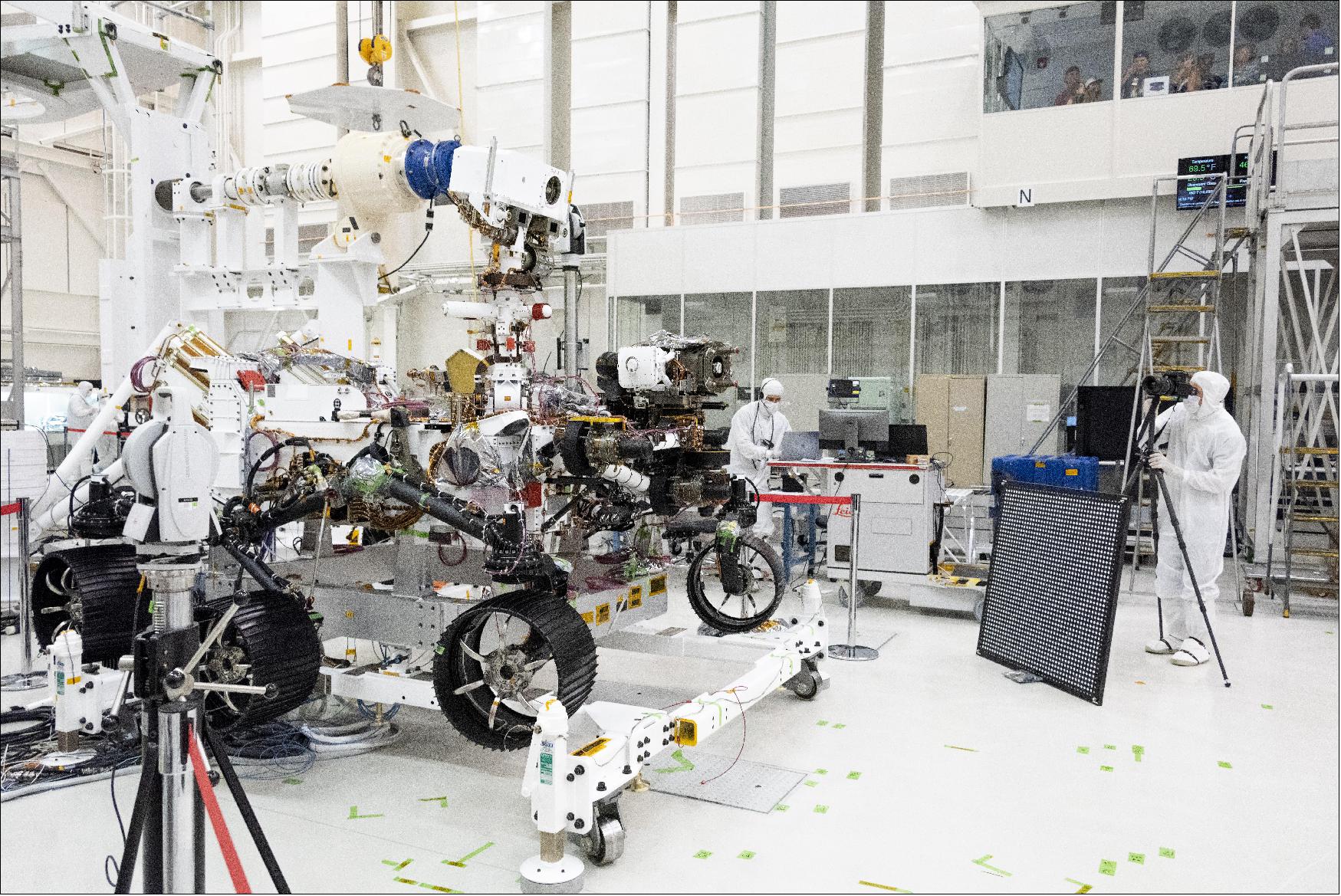
• August 2, 2019: Hardware installed onto NASA's Mars 2020 entry vehicle this week will help to increase the safety of future Mars landings. 2)
- Charged with returning astronauts to the Moon by 2024, NASA's Artemis lunar exploration plans will establish a sustained human presence on and around the Moon by 2028. NASA will use its Moon missions along with robotic missions to Mars to prepare for human exploration of the Red Planet.
- The Mars Entry, Descent and Landing Instrumentation 2 (MEDLI2) project developed a suite of sensors that will measure aerothermal environments and the performance of thermal protection system (TPS) material during the entry phase on the Mars 2020 mission. Engineers installed the first batch of items delivered by MEDLI2 onto the heat shield of the entry vehicle this week. The aeroshell of the entry vehicle consists of a heat shield and backshell and will protect the Mars 2020 rover in transit from Earth to Mars and during the entry through the atmosphere of Mars on its way to the surface.
- "Understanding the actual performance of our current generation of entry vehicles is crucial to safe, reliable landing of future robotic and crewed Mars missions. MEDLI2 pressure and thermal measurements are the key to that understanding," said Todd White, MEDLI2 principal investigator.
- MEDLI2 recently completed environmental testing on flight hardware at NASA's Langley Research Center in Hampton, Virginia. The testing, including vibration and thermal vacuum testing, demonstrates the ability of the hardware to survive the large vibratory loads experienced during the launch and the extreme cold during the cruise to Mars. High-temperature sterilization of some of the hardware has also been successfully concluded, allowing MEDLI2 to minimize the potential of transporting terrestrial biological material unintentionally to the surface of Mars. All of the MEDLI2 components are set to be completely installed on the Mars 2020 aeroshell by the end of November 2019.
- MEDLI2 includes three types of sensors (thermocouples, heat flux sensors and pressure transducers), a data acquisition and signal conditioning unit (the Sensor Support Electronics Unit) to record the heating and atmospheric pressure experienced during entry and through parachute deployment, and the harnessing between the sensors and the Sensor Support Electronics unit. Building on the first MEDLI suite, which flew on NASA's Mars Science Laboratory mission, instrumentation is again being applied to the heat shield, but in a different configuration to better measure the flow characteristics. This time instrumentation is being installed on the backshell as well to collect measurements of the heating and the surface pressure to aid in reducing the large uncertainty applied to the current predicted results.
- The Mars 2020 spacecraft will enter Mars' atmosphere traveling about 12,500 mph (20,120 kph). MEDLI2 will start to collect data about five hours prior to the entry and continue to collect data throughout the entry and part of the descent phases. It will take about 6 minutes to slow the spacecraft from 12,500 mph (20,120 kph) to just under 2 mph (3 km/h). MEDLI2 will measure crucial entry and descent performance data on the Mars 2020 heat shield and backshell.
- The key objectives of MEDLI2 are to reduce design margin and prediction uncertainties for the aerothermal environments and aerodynamic database. Close analysis of MEDLI2 flight data is vital to future NASA exploration of the Red Planet. MEDLI2 will explore areas not addressed during the Mars Science Laboratory (MSL) mission and seek answers to questions generated from examining MEDLI/MSL data.
- MEDLI2 is a Game Changing Development project led by NASA's Space Technology Mission Directorate with support from the Human Exploration and Operations Mission Directorate and the Science Mission Directorate. The project is managed at Langley and implemented in partnership with NASA's Ames Research Center in California's Silicon Valley and the Jet Propulsion Laboratory in Pasadena, California.
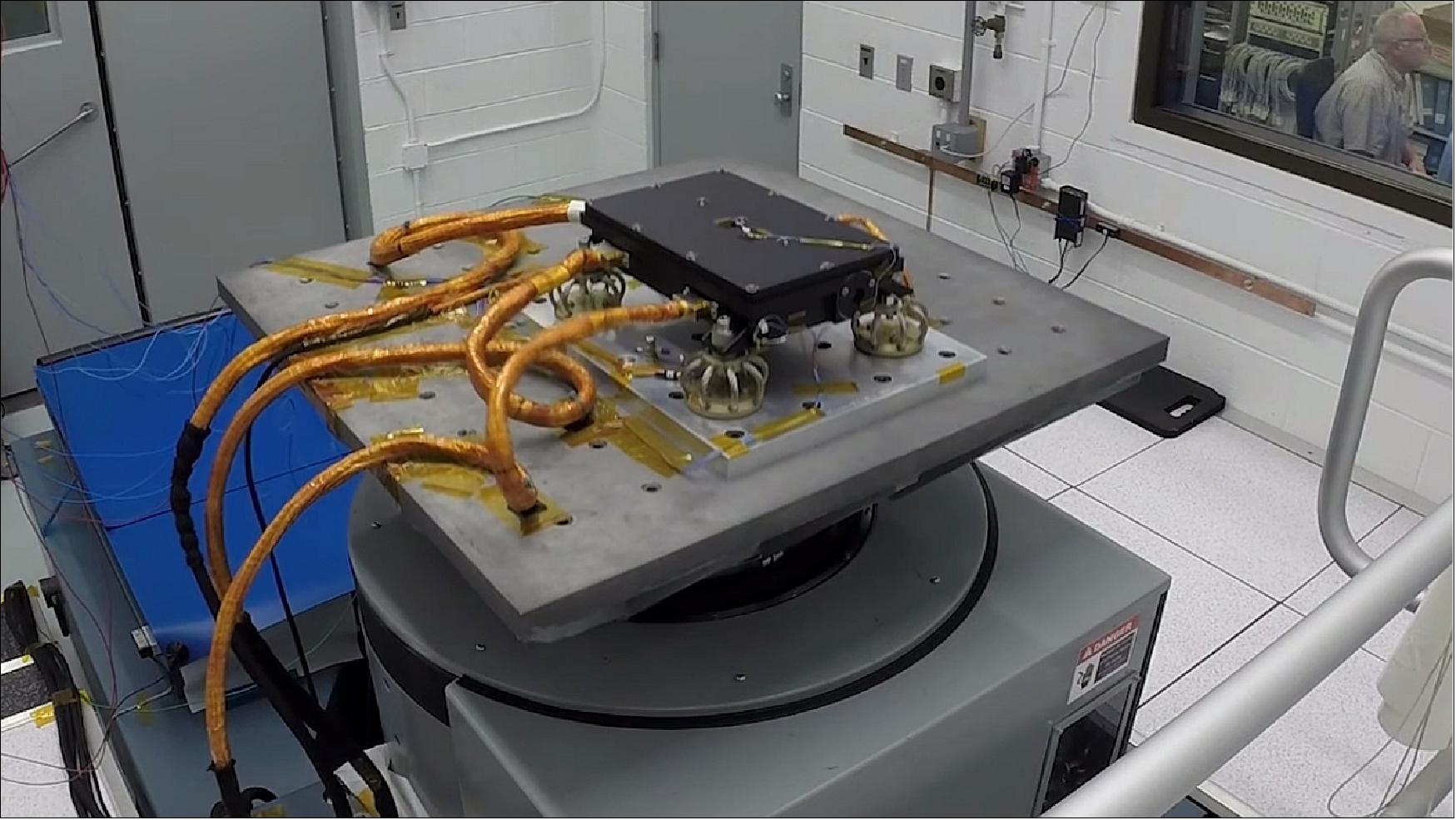
• July 24, 2019: NASA's Associate Administrator for the Science Mission Directorate, Thomas Zurbuchen, has given the go-ahead to begin fueling the Mars 2020 rover's MMRTG (Multi-Mission Radioisotope Thermoelectric Generator). The generator will power the rover and help keep it warm while exploring the Red Planet. 3)
- "The progression of the Mars 2020 rover project is on schedule," said Zurbuchen. "The decision to begin fueling the MMRTG is another important milestone in keeping to our timetable for a July 2020 launch."
- Essentially a nuclear battery, an MMRTG can provide about 110 W of electrical power to a spacecraft and its science instruments at the beginning of a mission. The excess heat from the generator can also serve to keep spacecraft systems warm in cold environments. In all, 27 past U.S. space missions have used radioisotope power - from the Viking missions on Mars to the Voyager spacecraft entering interplanetary space to, most recently, the Curiosity rover on Mars and the New Horizons spacecraft that sailed past Pluto.
- MMRTGs work by converting heat from the natural decay of radioisotope materials into electricity. The generators consist of two major elements: a heat source that contains plutonium-238 (Pu-238) and thermocouples that convert the plutonium's decay heat energy to electricity. The process of loading the heat source into the MMRTG, which the Department of Energy (DOE) manufactured, is timed to a mission's launch date. The Mars 2020 fueling process has been initiated thanks to the continued progress constructing the rover and the spacecraft that will get it there.
- "We are advancing on all fronts - including completion of the cruise stage that will guide us to Mars and the sky crane descent landing system that will gently lower us to the surface," said Project Manager John McNamee of NASA's Jet Propulsion Laboratory, which manages the mission in Pasadena, California. "And the rover is not only looking more and more like a rover each day, it's acting like one."
- With the exception of incorporating the Adaptive Caching Assembly, with its seven motors and more than 3,000 parts, work on the Mars 2020 rover's interior is 100% complete. On the exterior, the most visible additions have been the remote sensing mast, the mobility suspension system, the main robotic arm and the rover's high-gain antenna. The external components of the Mastcam-Z and SuperCam science instruments have been installed on the high perch of the remote sensing mast, and the PIXL and SHERLOC instruments' turret assemblies have been added onto the end of the robotic arm.
- "Our Mars 2020 rover is on a historic mission - the first leg of a round trip to Mars," said Zurbuchen. "We want everyone to come along for this extraordinary voyage, whether it's by watching the rover's final assembly online, literally sending your name to go to Mars or following NASA's updates on the mission."
- Mars 2020 will launch from Cape Canaveral Air Force Station in Florida in July 2020 and land at Jezero Crater on Feb. 18, 2021. It will be the first spacecraft in the history of planetary exploration with the ability to accurately retarget its point of touchdown during the landing sequence - technology that could prove essential to future crewed missions to the Moon and Mars.
- NASA will use Mars 2020 and other missions,including those to the Moon,to prepare for human exploration of the Red Planet. The agency plans to establish a sustained human presence on and around the Moon by 2028 through NASA's Artemis lunar exploration plans.
- JPL is part of the Radioisotope Power Systems program and manages several missions that utilize radioisotope power, including the Mars Curiosity rover and the upcoming Mars 2020 rover.
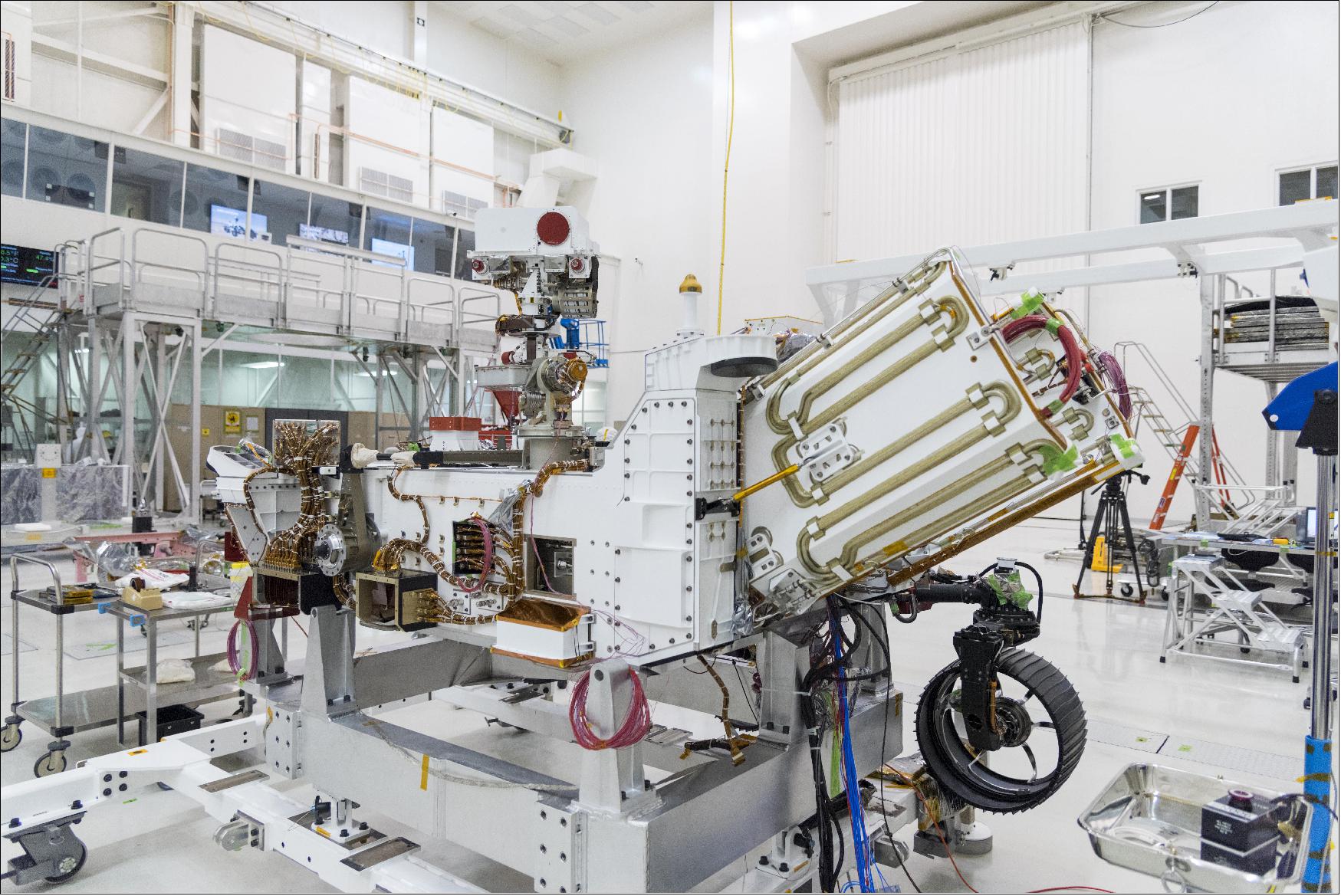
• July 17, 2019: The launch period for NASA's Mars 2020 rover opens exactly one year from today, July 17, 2020, and extends through Aug. 5, 2020. The mission will launch from Cape Canaveral Air Force Station in Florida and land at Mars' Jezero Crater on Feb. 18, 2021. 4)
- "Back when we started this project in 2013, we came up with a timeline to chart mission progress," said John McNamee, Mars 2020 project manager at NASA's Jet Propulsion Laboratory in Pasadena, California. "That every single major spacecraft component on a project with this level of innovation is synching right now with that timeline is a testament to the innovation and perseverance of a great team."

• July 2, 2019: Engineers at NASA/JPL have installed the SuperCam Mast Unit onto the Mars 2020 rover. The instrument's camera, laser and spectrometers can identify the chemical and mineral makeup of targets as small as a pencil point from a distance of 6 m. 5)
- SuperCam is a next-generation version of the ChemCam instrument operating on NASA's Curiosity Mars rover. It has been developed jointly in the U.S., France and Spain. Once France delivered the last piece of flight hardware, the instrument was fully integrated on the Mars 2020 rover on June 25, 2019, in the Spacecraft Assembly Facility's High Bay 1 clean room at JPL.
- "SuperCam has come a long way from being a bold and ambitious idea to an actual instrument," said Sylvestre Maurice, the SuperCam deputy principal investigator at the Institut de Recherche en Astrophysique et Planétologie in Toulouse, France. "While it still has a long way to go - all the way to Mars - this is a great day for not only SuperCam but the amazing consortium that put it together."
- Mars 2020 scientists will use SuperCam to examine Martian rocks and soil, seeking organic compounds that could be related to past life on Mars.
- "SuperCam's rock-zapping laser allows scientists to analyze the chemical composition of its targets," said Soren Madsen, the payload development manager at JPL. "It lets the Mars 2020 rover conduct its cutting-edge science from a distance."
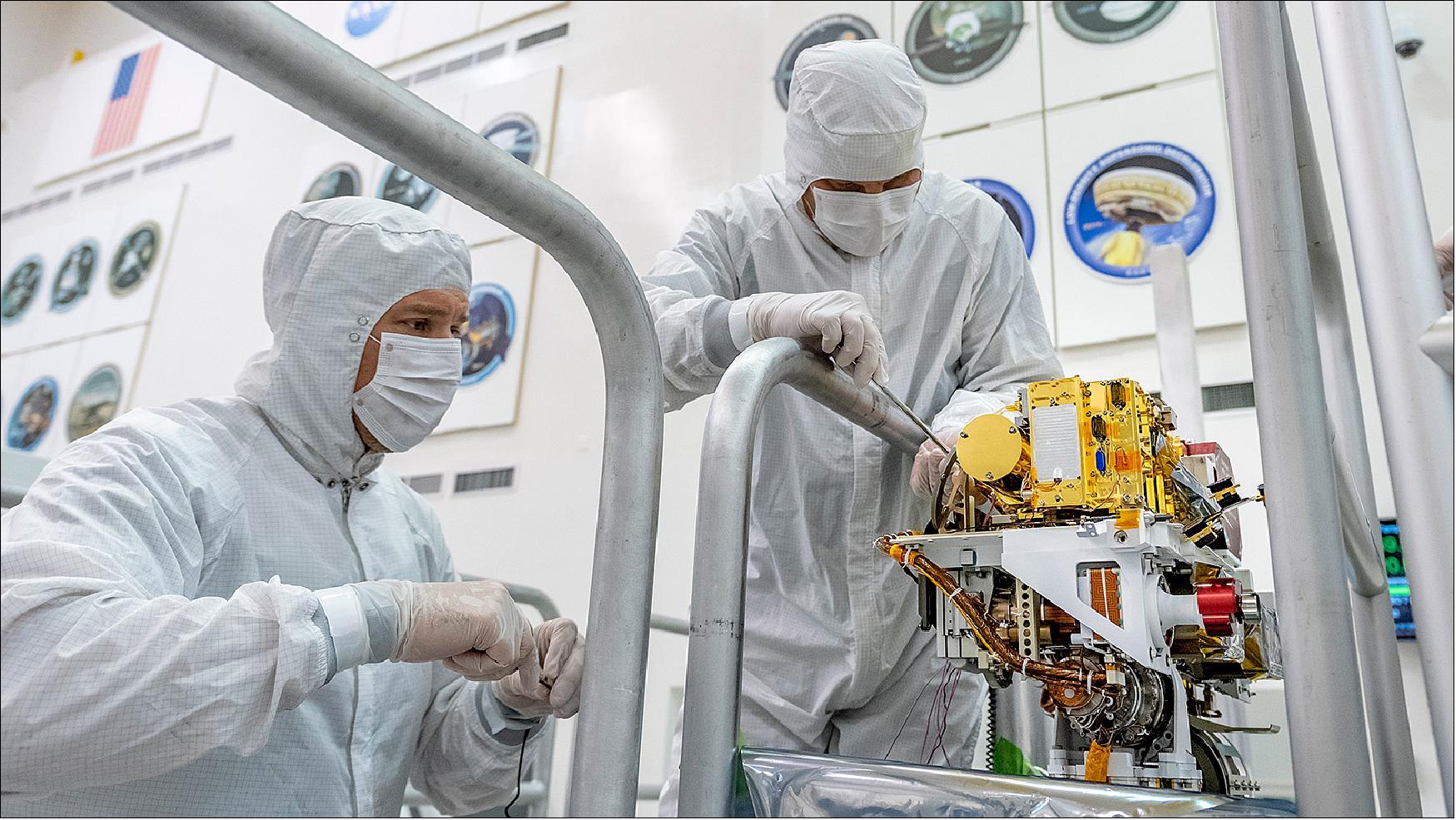
- Also to be installed in the next few weeks is Mars 2020's Sample Caching System, which includes 17 separate motors and will collect samples of Martian rock and soil that will be left on the surface of Mars for return to Earth by a future mission.
- Mars 2020 will launch from Cape Canaveral Air Force Station in Florida in July of 2020. It will land at Jezero Crater on Feb. 18, 2021.
- NASA will use Mars 2020 and other missions, including to the Moon, to prepare for human exploration of the Red Planet. The agency plans to establish a sustained human presence on and around the Moon by 2028 through NASA's Artemis lunar exploration plans.
- SuperCam is led by Los Alamos National Laboratory in New Mexico, where the instrument's Body Unit was developed. That part of the instrument was installed in the body of the rover in May and includes several spectrometers, control electronics and software. The Mast Unit was built with contributions from numerous academic laboratories in France, led by the French space agency Centre National d'Études Spatiales, and includes the high-powered laser, a telescope, a camera, an infrared spectrometer and a microphone. Calibration targets on the rover deck are provided by Spain's University of Valladolid.
• July 1, 2019: The view of the Sea of Tranquility rising up to meet Neil Armstrong during the first astronaut landing on the Moon was not what Apollo 11 mission planners had intended. They had hoped to send the lunar module Eagle toward a relatively flat landing zone with few craters, rocks and boulders. Instead, peering through his small, triangular commander's window, Armstrong saw a boulder field - very unfriendly for a lunar module. So the Apollo 11 commander took control of the descent from the onboard computer, piloting Eagle well beyond the boulder field,to a landing site that will forever be known as Tranquility Base. 6)
- "There had been Moon landings with robotic spacecraft before Apollo 11," said Al Chen, entry, descent and landing lead for NASA's Mars 2020 mission at the Jet Propulsion Laboratory in Pasadena, California. "But never before had a spacecraft on a descent toward its surface changed its trajectory to maneuver out of harm's way."
- Chen and his Mars 2020 colleagues have experience landing spacecraft on the Red Planet without the help of a steely-eyed astronaut at the stick. But Mars 2020 is headed toward NASA's biggest Martian challenge yet. Jezero Crater is a 28-mile-wide (45 km wide) indentation full of steep cliffsides, sand dunes, boulders fields and small impact craters. The team knew that to attempt a landing at Jezero - and with a rover carrying 50% more payload than the Curiosity rover, which landed at a more benign location near Mount Sharp - they would have to up their game.
- "What we needed was a Neil Armstrong for Mars," said Chen. "What we came up with was Terrain-Relative Navigation."
- Carried aboard Mars 2020, TRN (Terrain-Relative Navigation) is an autopilot that during landing can quickly figure out the spacecraft's location over - and more importantly, calculate its future location on - the Martian surface. Onboard, the rover's computer stores a map of hazards within Jezero Crater, and if the computed landing point is deemed too dangerous, TRN will command Mars 2020's descent stage to fly the rover to the safest reachable landing point.
A Two-Part System
- To land an Apollo lunar module on the Moon required a crew of two (Armstrong had Buzz Aldrin feeding him information on their trajectory). Likewise, Terrain-Relative Navigation is actually two systems working together: the Lander Vision System and the Safe Target Selection system.
- "The first half of Terrain-Relative Navigation is the LVS ( Lander Vision System), which determines where the spacecraft is over the Martian surface," said Andrew Johnson, guidance navigation and control subsystem manager for Mars 2020. "If you say it quick - LVS - you'll understand why the team's unofficial mascot is Elvis Presley."
- LVS's operational lifetime is all of 25 seconds. It comes alive at about 13,000 feet (3,960 meters), commanding a camera on the rover to quickly take picture after picture of the Martian surface while still descending on a parachute. LVS scrutinizes one image a second, breaking each into squares that cover about 1,520 m of surface area.
- However, unlike Neil Armstrong, LVS's real-time analysis isn't looking for specific crater rims or mountain peaks. Instead, inside each of those boxes, or landmarks, the system looks for unique patterns in contrasting light and dark created by surface features like cliffs, craters, boulder fields and mountains. It then compares any uncommon pattern with a map in its memory. When it finds five landmark matches during Coarse Landmark Matching mode, it takes another image and repeats the process.
- After three successful image-to-map comparisons, LVS kicks into a mode called Fine Landmark Matching. That's when the system breaks the surface into boxes 125 meters across, scanning for unique patterns and comparing them with the map. LVS is looking for at least 20 matches in that one second of eyeballing an image but usually makes much more - up to 150 - in order to generate an even more accurate plot of Mars 2020's trajectory.
- "Each time a suitable number of matches is made in an image, in either Course or Fine Landmark Matching, LVS updates where the spacecraft is at that moment," said Johnson. "That update is then fed into the Safe Target Selection system."
- This second part of the Terrain-Relative Navigation system uses LVS's position solution, calculates where it will land and then compares it to another onboard map, this one depicting areas within the landing zone understood to be either good for landing ... or the kind with craters, cliffsides, boulders or rocks fields. If the plotted location isn't suitable, Safe Target Selection can change the rover's destiny, moving its landing point by up to 600 m.
Put to the Test
- While Safe Target Selection operations can be investigated in a computer testbed within the confines of JPL, to gather optical data, the team needed to go farther afield: the Mojave Desert and Death Valley.
- Over three weeks in April and May of 2019, LVS flew 17 flights attached to the front of a helicopter, taking and processing image after image over the Mars-like terrain of Kelso Dunes, Hole-in-the-Wall, Lava Tube, Badwater, Panamint Valley and Mesquite Flat Dunes.
- "We flew flight after flight, imitating the descent profile of the spacecraft," said Johnson. "In each flight we performed multiple runs. Each run essentially imitated a Mars landing."
- All in all, the equivalent of 659 Mars landings took place during the test flights.
- "The data is in - TRN works," said Chen. "Which is a good thing because Jezero is where our scientists want to be. And without TRN, the odds of successful landing at a good location for the rover are approximately 85%. With TRN, we feel confident we are up around 99%."
- But Chen is also quick to note that Mars is hard: Only about 40% of all missions sent to Mars - by any space agency - have successfully landed.
- "To go farther we have to look to the past, and in that respect who better than the first?" said Chen. "In an interview some 35 years after Apollo 11, Neil Armstrong said, 'I think we tried very hard not to be overconfident. Because when you get overconfident, that's when something snaps up and bites you.'"
- Mindful of that, the Mars 2020 TRN team's work will conclude only on Feb. 18, 2021, a little after 12 p.m. PST (3 p.m. EST), when their rover alights on Jezero Crater. But it is also just a beginning: Terrain-Relative Navigation's autonomous precision guidance could prove essential to landing humans safely on both the Moon and Mars. TRN could also be useful for landing equipment in multiple drops ahead of a human crew on either world - or others to be explored down the road.
• June 20, 2019: "Now that's a Mars rover," said David Gruel, the Mars 2020 assembly, test, and launch operations manager at JPL. "With the suspension on, not only does it look like a rover, but we have almost all our big-ticket items for integration in our rearview mirror - if our rover had one." 7)
- Within the next few weeks, the team expects to install the vehicle's robotic arm, the mast-mounted SuperCam instrument and the Sample Caching System, which includes 17 separate motors and will collect samples of Martian rock and soil that will be returned to Earth by a future mission.
- Both of the rover's legs (the starboard leg's black tubing can be seen above the wheels) are composed of titanium tubing formed with the same process used to make high-end bicycle frames. The wheels in this picture are engineering models and will not make the trip to Mars. They will be swapped out for flight models of the wheels sometime next year.
- Made of aluminum, each of the six wheels (each 52.5 cm in diameter) features 48 grousers, or cleats, machined into its surface to provide excellent traction both in soft sand and on hard rocks. Every wheel has its own motor. The two front and two rear wheels also have individual steering motors that enable the vehicle to turn a full 360 degrees in place.
- When driving over uneven terrain, the suspension system - called a "rocker-bogie" system due to its multiple pivot points and struts -maintains a relatively constant weight on each wheel and minimizes rover tilt for stability. Rover drivers avoid terrain that would cause a tilt of more than 30 º, but even so, the rover can withstand a 45º tilt in any direction without tipping over. With its suspension, the rover can also roll over rocks and other obstacles as well as through depressions the size of its wheels.
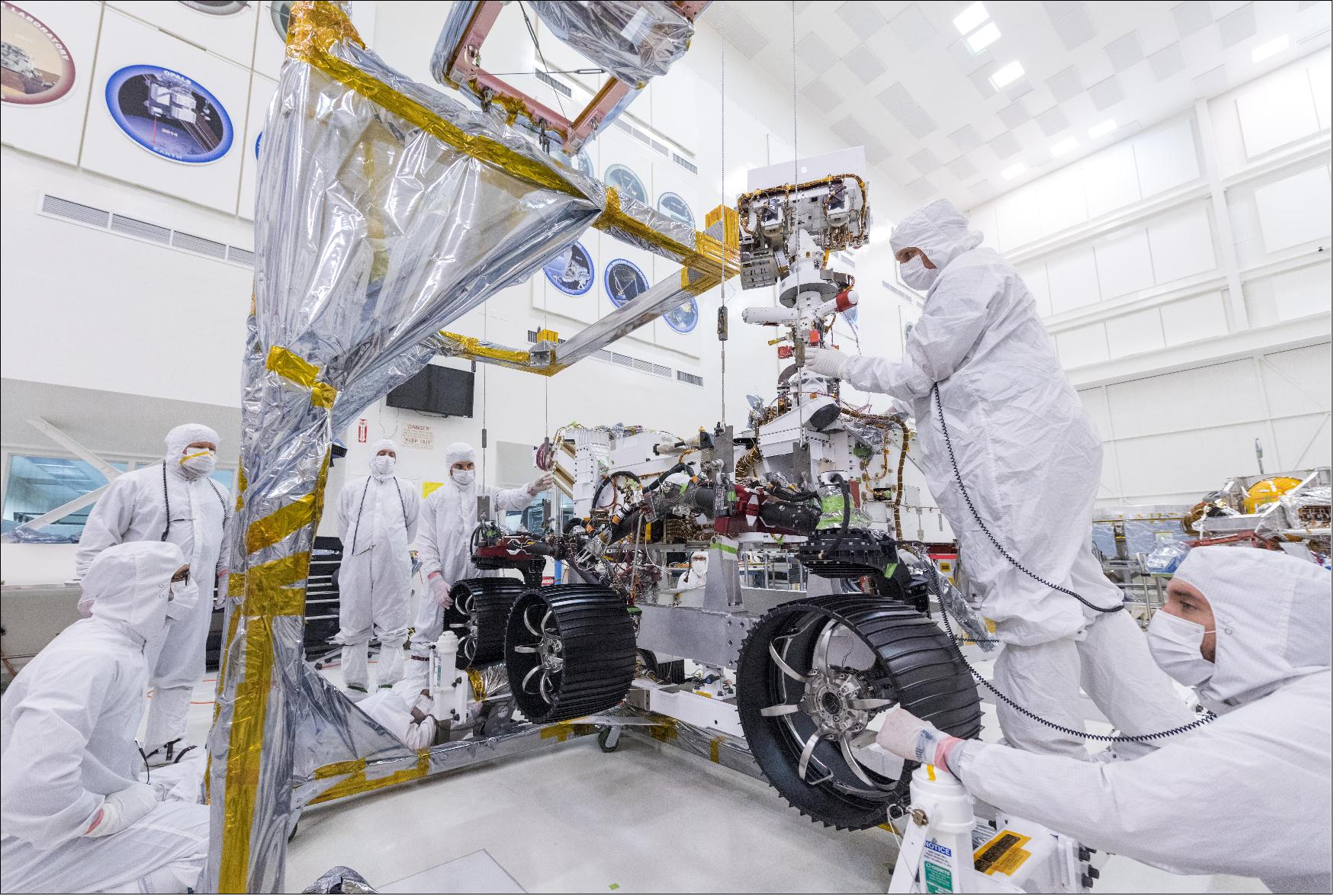
• June 12, 2019: When a female astronaut first sets foot on the Moon in 2024, the historic moment will represent a step toward another NASA first: eventually putting humans on Mars. NASA's latest robotic mission to the Red Planet, Mars 2020, aims to help future astronauts brave that inhospitable landscape. 8)

- While the science goal of the Mars 2020 rover is to look for signs of ancient life - it will be the first spacecraft to collect samples of the Martian surface, caching them in tubes that could be returned to Earth on a future mission - the vehicle also includes technology that paves the way for human exploration of Mars.
- The atmosphere on Mars is mostly carbon dioxide and extremely thin (about 100 times less dense than Earth's), with no breathable oxygen. There's no water on the surface to drink, either. The landscape is freezing, with no protection from the Sun's radiation or from passing dust storms. The keys to survival will be technology, research and testing.
- Mars 2020 will help on all those fronts. When it launches in July of 2020, the spacecraft will carry the latest scientific and engineering tools, which are coming together as the rover is built at NASA's Jet Propulsion Laboratory in Pasadena, California. Here's a closer look.
Touchdown
- Every landing on Mars offers a learning opportunity. With Mars 2020, that includes how the spacecraft's heat shield and parachute perform in the planet's atmosphere, and how well its radar can sense the approaching surface. Sensors in the spacecraft's aeroshell (the capsule that encloses the rover) will study how it heats up and performs during atmospheric entry. These Mars Entry, Descent and Landing Instrumentation 2 (MEDLI2) sensors could help engineers improve their landing designs for big payloads like astronaut equipment and habitats.
- Landing a rover like this one also gives NASA more experience putting a heavy spacecraft on the surface of Mars; the challenge of landing in the thin Martian atmosphere scales with mass. The first crewed spacecraft will be titanic by comparison, carrying with it life support systems, supplies and shielding.
- Finally, Mars 2020 has a guidance system that will take a step toward safer landings. Called Terrain Relative Navigation, this new system figures out where the spacecraft is headed by taking camera images during descent and matching landmarks in them to a preloaded map. If the spacecraft drifts toward dangerous terrain, it will divert to a safer landing target.
- Terrain Relative Navigation allowed the 2020 team to select a landing site, Jezero Crater, that was considered too risky for previous missions. This kind of autonomous guidance could prove essential to landing humans safely. It would also be useful for landing equipment in multiple drops ahead of a human crew.
Oxygen
- Living on Mars will require a steady supply of oxygen, which would be costly to transport from Earth in the necessary volumes. A cube-shaped device called the Mars Oxygen In-Situ Resource Utilization Experiment (MOXIE) is exploring a space-saving alternative that converts carbon dioxide - which constitutes about 96% of the Martian atmosphere - into oxygen. Although MOXIE is a small-scale demonstration, the hope is that its technology could evolve into bigger and more efficient oxygen generators in the future. Those would allow astronauts to create their own breathable air and would provide oxygen to burn rocket fuel needed to return humans to the Earth.
- More importantly, MOXIE's descendants would save precious space on the first crewed vehicle to Mars. Not only would that leave more room for supplies, it could also reduce the cost and difficulty of getting from Earth to Mars.
Water
- Satellites orbiting the Red Planet regularly peek underground using radar, but Mars 2020 is carrying a ground-penetrating radar called the Radar Imager for Mars' Subsurface Experiment (RIMFAX) that will be the first operated at the Martian surface. Mars 2020 scientists will use its high-resolution images to look at buried geology, like ancient lake beds. But such a radar could one day be used to find stores of underground ice that astronauts could access to provide drinking water. Jezero Crater is unlikely to have any such caches, but many exist elsewhere on Mars.
Spacesuits
- Dust and radiation are part of every Martian weather forecast. Dust blows everywhere, sticking to spacecraft and covering solar panels. And because the planet doesn't have a magnetic field, as Earth does, the Sun's radiation bathes the Martian surface. The orbits of Earth and Mars align best for interplanetary travel every two years, meaning the first astronauts on the Red Planet are likely to endure long exposures to radiation.
- To help engineers design spacesuits to shield astronauts from the elements, NASA is sending five samples of spacesuit material along with one of Mars 2020's science instruments, called Scanning Habitable Environments with Raman & Luminescence for Organics & Chemicals (SHERLOC). A piece of an astronaut's helmet and four kinds of fabric are mounted on the calibration target for this instrument. Scientists will use SHERLOC, as well as a camera that photographs visible light, to study how the materials degrade in ultraviolet radiation. It will mark the first time spacesuit material has been sent to Mars for testing and will provide a vital comparison for ongoing testing at NASA's Johnson Space Center.
Shelter
- Humans exploring the Red Planet will need more than good spacesuits; they'll need a place to live. Mars 2020 will collect science that may help engineers design better shelters for future astronauts. Like NASA's Curiosity rover and InSight lander, 2020 has weather instruments to study how dust and radiation behave in all seasons. This suite of sensors, called the Mars Environmental Dynamics Analyzer (MEDA), is the next step in the kind of weather science Curiosity collects.
• June 11, 2019:
• May 31, 2019: One of the first operations the Mars 2020 rover will perform after touching down on the Red Planet's Jezero Crater on Feb. 18, 2021, will be to raise its RSM (Remote Sensing Mast), which carries important optics and instrumentation. 9)
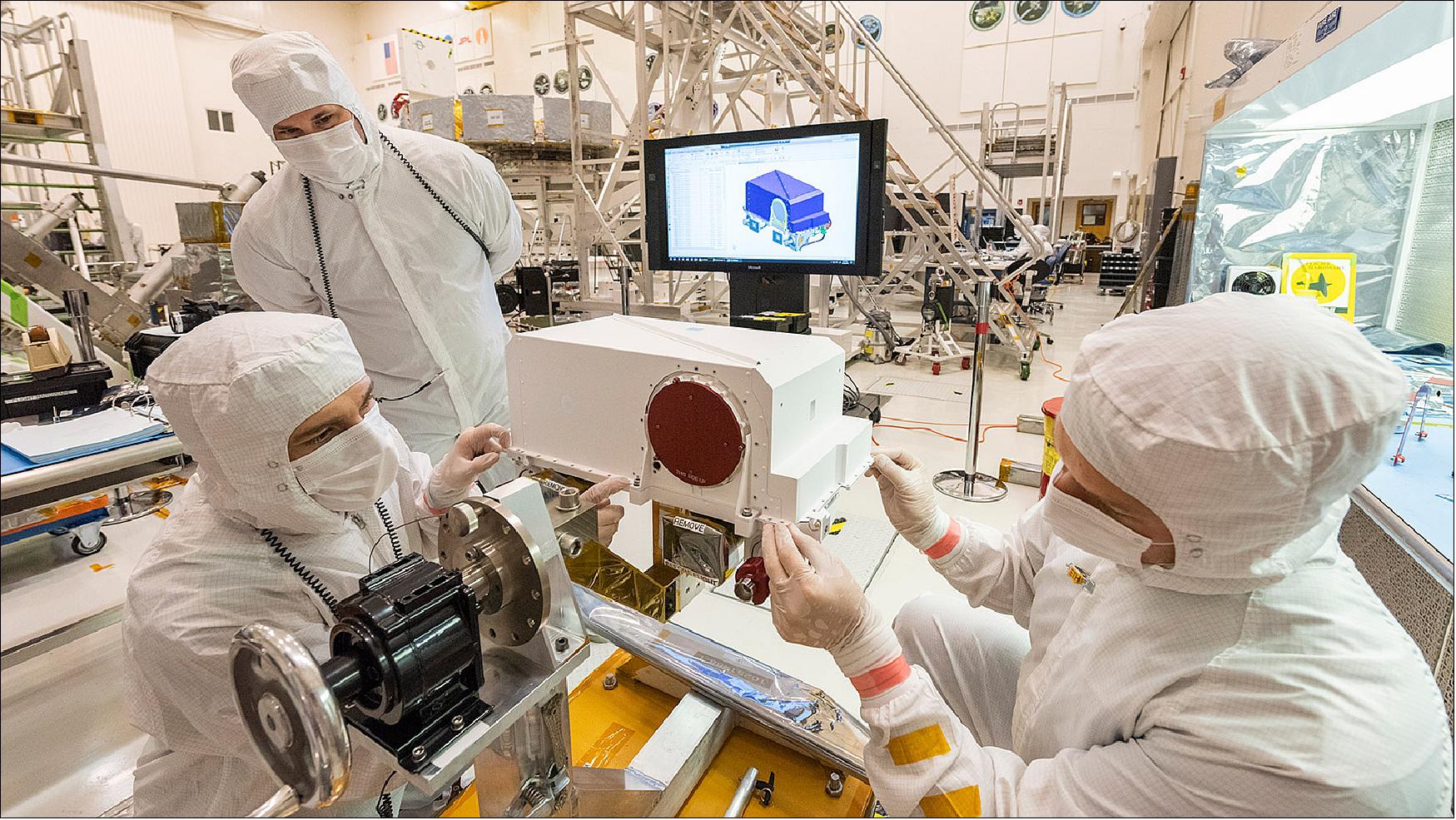
- Mastcam-Z is a multispectral, stereoscopic imaging instrument that will enhance the Mars 2020 rover's driving and core-sampling capabilities. It will also enable science team members to observe textural, mineralogical, structural and morphologic details in rocks and sediment at any location within the rover's field of view, helping them piece together the planet's geologic history.
- "Mastcam-Z will be the first Mars color camera that can zoom, enabling 3D images at unprecedented resolution," said Mastcam-Z Principal Investigator Jim Bell of Arizona State University in Tempe. "With a resolution of three-hundredths of an inch [0.8 millimeters] in front of the rover and less than one-and-a-half inches [38 millimeters] from over 330 feet [100 meters] away - Mastcam-Z images will play a key role in selecting the best possible samples to return from Jezero Crater."
- Mastcam Z's capabilities are not the only firsts of the mission. Mars 2020 will be the first spacecraft in the history of planetary exploration with the ability to accurately retarget its point of touchdown during the landing sequence. And the rover carries a sample-caching system that will collect Martian rock and soil samples and store them on the planet's surface for retrieval and return to Earth by subsequent missions.
• May 23, 2019: NASA's Mars 2020 spacecraft has completed acoustic and TVAC (Thermal Vacuum) testing at the Jet Propulsion Laboratory in Pasadena, California. The acoustic test of the spacecraft that will carry the Mars 2020 rover to a soft touchdown in Jezero Crater on Feb. 18, 2021, is the best Earthly approximation for what the spacecraft will endure during launch, where it will encounter potentially destructive levels of sound and vibration. TVAC introduces the vacuum and extreme temperatures of space that could cause components to malfunction or fail. 10)
- "First we blast it with sound to make sure nothing vibrates loose," said David Gruel, the Mars 2020 assembly, test and launch operations manager at JPL. "Then, after a thorough examination, we 'put it in space' by placing the spacecraft in this huge vacuum chamber we have here at JPL. We pump out the atmosphere, then chill parts of it and cook others while testing the performance of the entire spacecraft."
• May 17, 2019: From the top down, and suspended by cables, is the complete cruise stage, which will power and guide the Mars 2020 spacecraft on its seven-month voyage to the Red Planet. Directly below that is the aeroshell (white back shell and barely visible black heat shield), which will protect the vehicle during cruise as well as during its fiery descent into the Martian atmosphere. Not visible (because it's cocooned inside the aeroshell) is the completed rocket-powered descent stage and the surrogate rover (a stand-in for the real rover, which is undergoing final assembly in JPL's High Bay 1 cleanroom). 11)
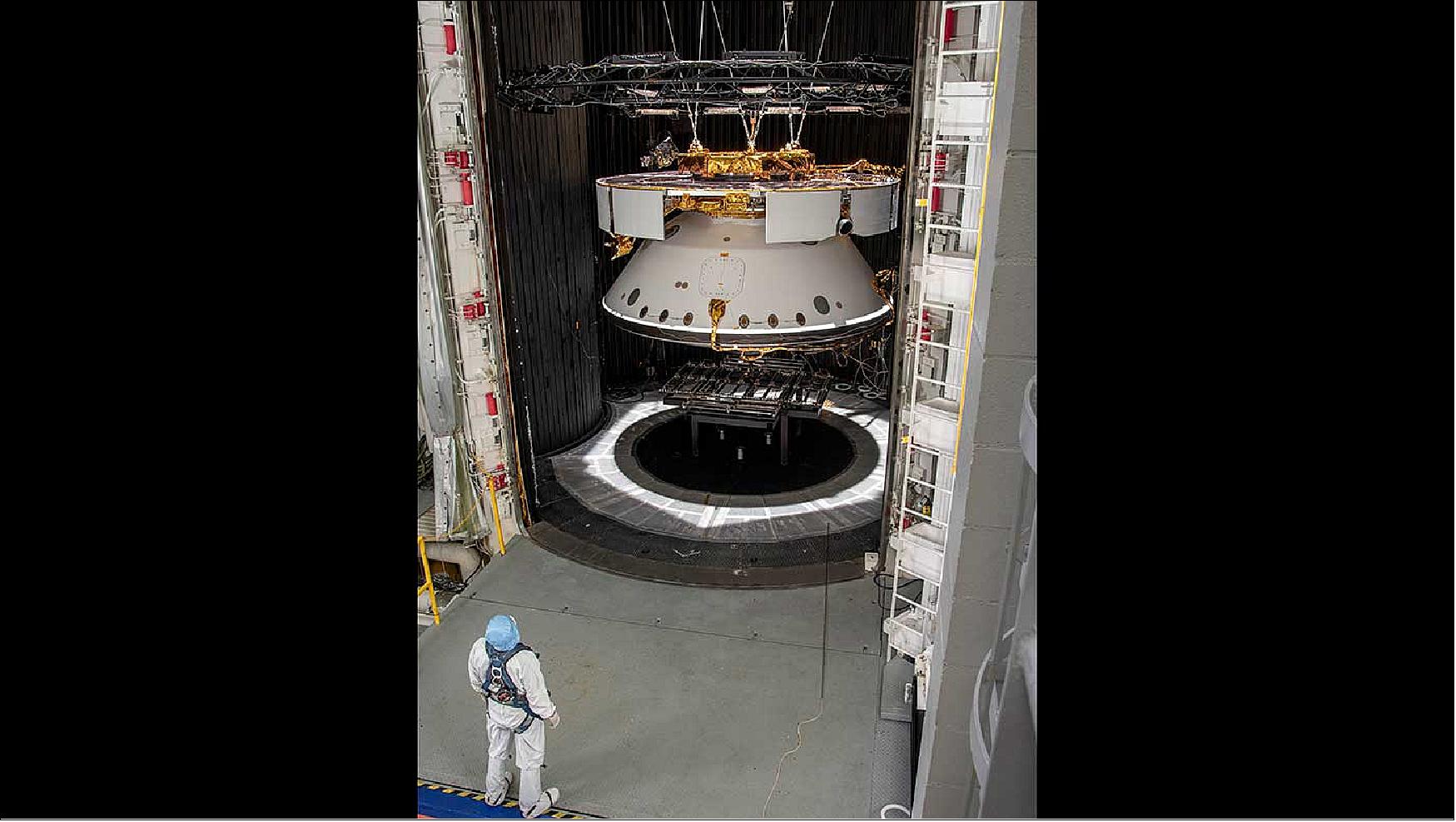
- The Mars 2020 spacecraft was tested in the 8-meter-by-26-meter chamber in the same configuration it will be in while flying through interplanetary space. The 2020 rover carries an entirely new suite of instruments, including a sample-caching system that will collect samples of Mars for return to Earth on subsequent missions. The mission will launch from Cape Canaveral Air Force Station in Florida in July of 2020 and land at Jezero Crater on 18 February 2021.
• May 2, 2019: Protecting against the extremes of space travel is critical to the success of any mission. Lockheed Martin has successfully completed the flight hardware structure of the heat shield, validating the physical integrity with a final static test after exposing it to flight-like thermal conditions. The heat shield is half of the large and sophisticated two-part aeroshell that Lockheed Martin is designing and building to encapsulate NASA Jet Propulsion Laboratory's Mars 2020 rover from the punishing heat and friction of entry through the Martian atmosphere. 12)
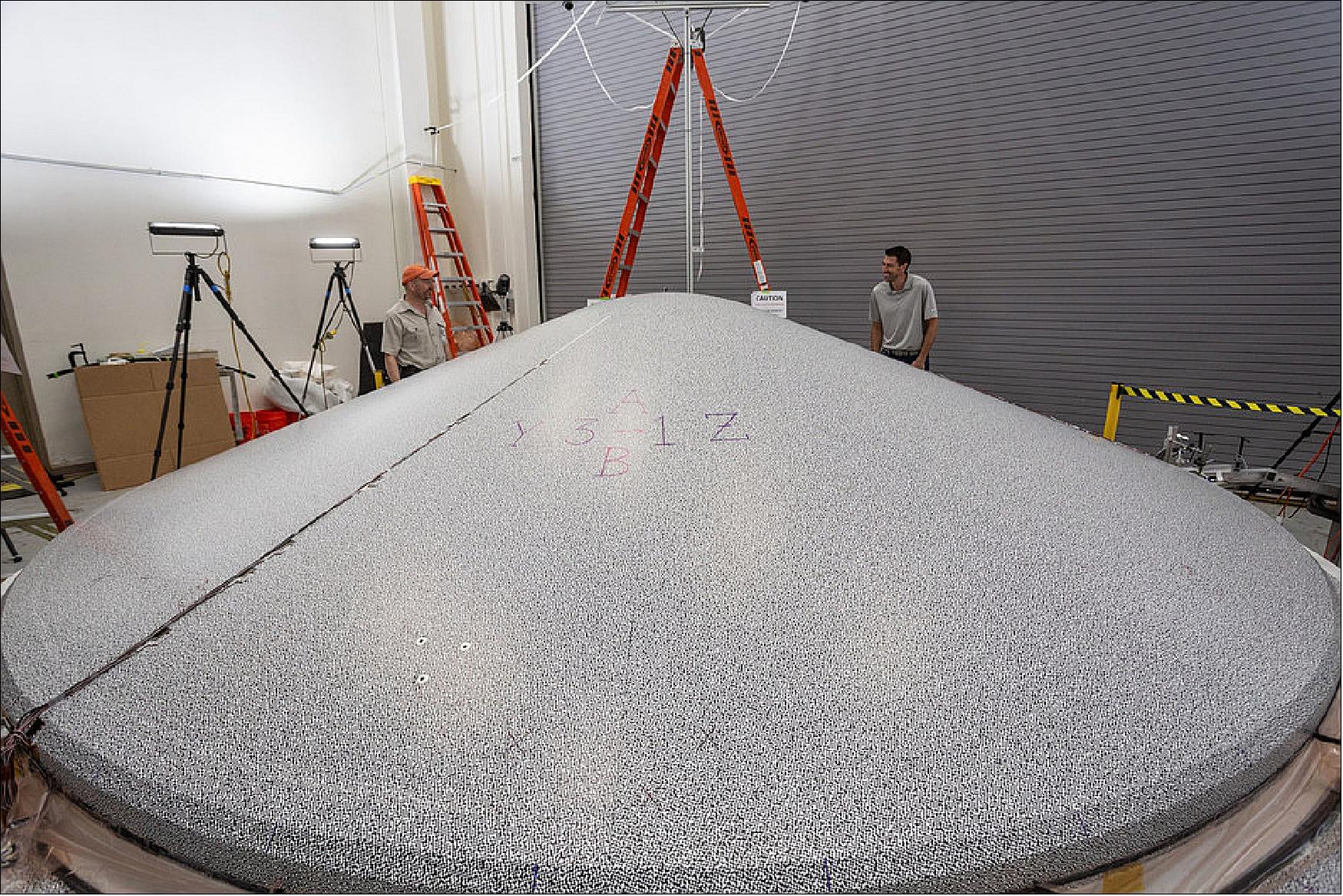
- The Mars 2020 mission will be one of the most challenging entry, descent and landings ever attempted on the Red Planet. The heat shield aerodynamics serve as a "brake" to slow the spacecraft from about 19,300 km/h so the structure needs to be flawless. As the tenth aeroshell system that Lockheed Martin has produced for NASA, this is one of the largest at 4.5 meters in diameter.
- "Our experience building aeroshells for NASA Mars missions does not mean that it is 'easy'," said Neil Tice, Lockheed Martin Mars 2020 Aeroshell program manager. "Tests like this structural test are absolutely essential to ensuring mission success in the long-run."
- The static test was conducted on 25 April and was designed to mimic the load that the heat shield will experience during the most extreme part of its journey; the entry phase. To do that, engineers used vacuum pumps to simulate the pressure of approximately 140,000 pounds on the structure. The structure was tested to 120% of the expected flight load to push it to the limit.
- For this particular test, the team also integrated a new form of instrumentation. Historically, this test utilizes conventional strain gauges and extensometers to monitor structural response at distinct points during loading. Partnering with NASA Langley Research Center, the team also applied a new tool called Photogrammetry or Digital Image Correlation. This allowed the team to monitor full-field strains and displacements over the entire visible area of the structure in realtime. To use this technique, a vinyl wrap, similar to a decal, that has different visual cues (dark random speckles over a white background) was applied to the heat shield. During the test, a set of digital cameras optically monitor any changes in the pattern and generate a three-dimensional map of displacements and surface strains as the applied load increases.
- "While we have used this full-field photogrammetry technique on test articles in the past, this is the first successful implementation on official flight hardware," said Dr. Sotiris Kellas, NASA Langley aerospace engineer and lead for the technical demonstration. "This technology will allow us to safeguard hardware during testing but more importantly provide data for test analysis correlation and improvement of our design and analysis tools."
- Following this test, the Lockheed Martin team will apply Phenolic Impregnated Carbon Ablator (PICA) thermal protection system tiles to the structure. Once complete and through all environmental testing, the full heat shield will be mated to the backshell in early fall.
- The Mars 2020 Project at NASA/JPL manages the rover development for the Science Mission Directorate at NASA Headquarters in Washington. The NASA Engineering and Safety Center at NASA Langley Research Center provided the photogrammetry support for this test.
• April 24, 2019: Mars 2020 is Wired for Sound. 13)
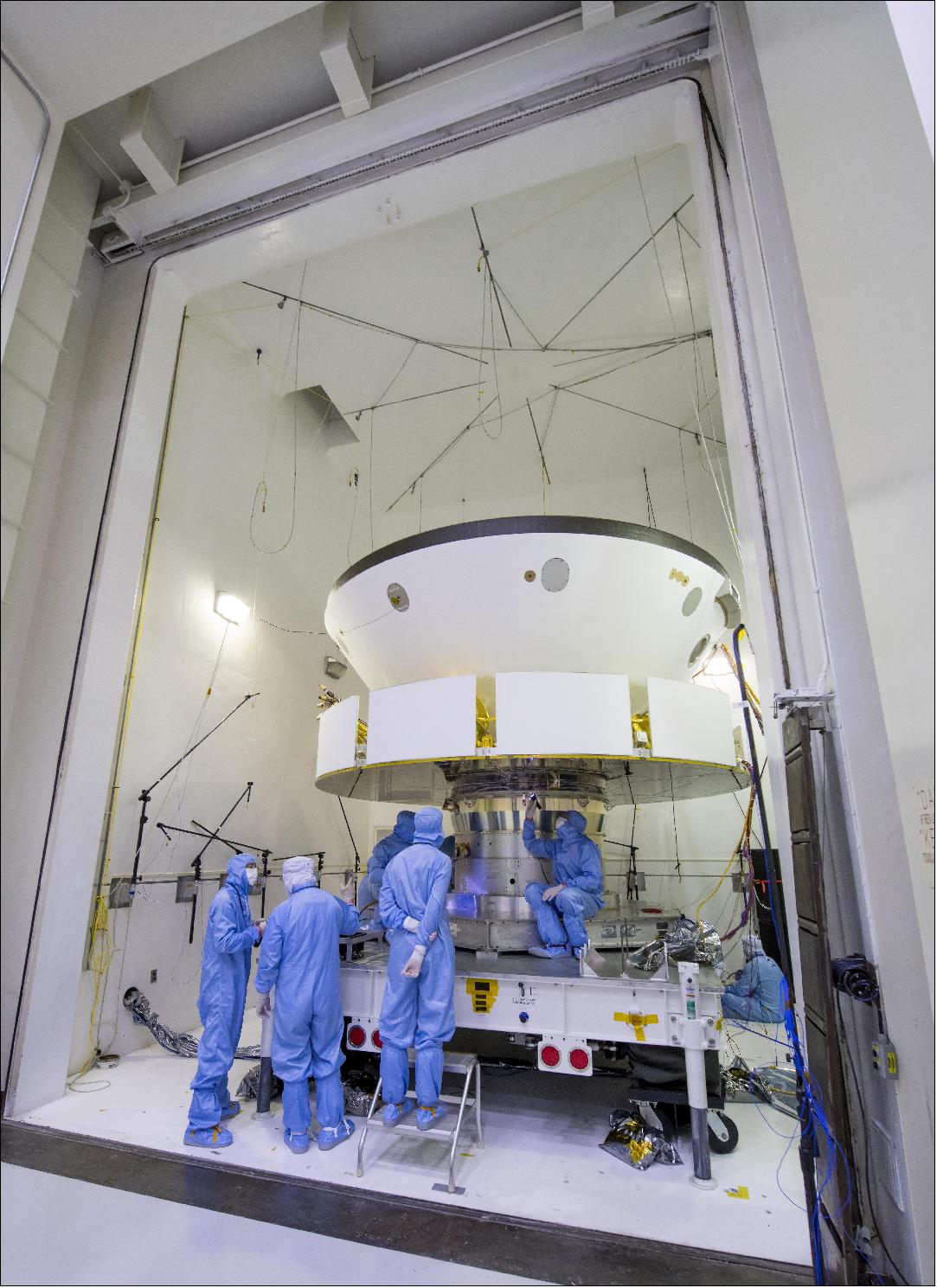
• March 19, 2019: In a little more than seven minutes in the early afternoon of 18 February 2021, NASA's Mars 2020 rover will execute about 27,000 actions and calculations as it speeds through the hazardous transition from the edge of space to Mars' Jezero Crater. While that will be the first time the wheels of the 1,050 kg rover touch the Red Planet, the vehicle's network of processors, sensors and transmitters will, by then, have successfully simulated touchdown at Jezero many times before. 14)
- "We first landed on Jezero Crater on 23 January," said Heather Bottom, systems engineer for the Mars 2020 mission at the Jet Propulsion Laboratory in Pasadena, California. "And the rover successfully landed again on Mars two days later."
- Bottom was the test lead for ST1 ( Systems Test 1), the Mars 2020 engineering team's first opportunity to take the major components of the Mars 2020 mission for a test drive. Over two weeks in January, Bottom and 71 other engineers and technicians assigned to the 2020 mission took over the High Bay 1 cleanroom in JPL's Spacecraft Assembly Facility to put the software and electrical systems aboard the mission's cruise, entry capsule, descent stage and rover through their paces.

- "ST1 was a massive undertaking," said Bottom. "It was our first chance to exercise the flight software we will fly on 2020 with the actual spacecraft components that will be heading to Mars — and make sure they not only operate as expected, but also interact with each other as expected."
- The heritage for Mars 2020's software goes back to the Mars Exploration Rovers (Spirit and Opportunity) and the Curiosity rover that has been exploring Mars' Gale Crater since 2012. But 2020 is a different mission with a different rover, a different set of science instruments and a different destination on Mars. Its software has to be tailored accordingly.
- Work began in earnest on the flight software in 2013. It was coded, recoded, analyzed and tested on computer workstations and laptops. Later, the flight software matriculated to spacecraft testbeds where it was exposed to computers, sensors and other electronic components customized to imitate the flight hardware that will launch with the mission in 2020.
- "Virtual workstations and testbeds are an important part of the process," said Bottom. "But the tens of thousands of individual components that make up the electronics of this mission are not all going to act, or react, exactly like a testbed. Seeing the flight software and the actual flight hardware working together is the best way to build confidence in our processes. Test like you fly."
Making the Grade
- On the day before ST1 began, the High Bay 1 cleanroom was hopping with "bunny suit"-clad engineers and technicians assembling, inspecting and testing the mission's hardware. The next day, Wednesday, Jan. 16, the room was eerily quiet. The majority of workers had been replaced by two technicians there to monitor the flight test hardware. Lines of electrical cabling — "umbilicals" — were added to provide data and power to the spacecraft's cruise stage, back shell, descent stage and rover chassis, which have yet to be stacked together. The ground to in-flight spacecraft (and in-flight spacecraft to ground) communications were handled by X-band radio transmission, just like they would be during the trip to Mars.
- ST1 began with commands to energize the spacecraft's electrical components and set up thermal, power and telecom configurations. While all the spacecraft components remained in the cleanroom, Bottom and her team had them thinking they were sitting on top of an Atlas 541 rocket 58 meters above Launch Complex 41 at Cape Canaveral on July 17, 2020, waiting to be shot into space.
- Next, they focused on another part of cruise before testing the landing sequence. Then they did it all over again.
- After a successful launch, they time jumped 40 days ahead to simulate deep space cruise. How would the software and hardware interact when they had to perform navigation fixes and trajectory correction maneuvers? And how would they work when simulated events didn't go as planned? The team looked for answers on the operators' computer screens in the test operations room beside the cleanroom.
- "From the test operations room, you could look out the windows onto the cleanroom floor and clearly see the flight hardware," said Bottom. "Nothing was visibly moving, but underneath the outer structure, there were flight computers swapping sides, radios sending and receiving transmissions, fuel valves moving in and out, subsystems being energized and later turned off, and electrical signals being sent to nonexistent pyrotechnic devices. There was a lot going on in there."
- On 30 January, the Mars 2020 test team was able to close their 1,000-plus page book of procedures for ST1. They went two-for-two on Mars landings. They also launched four times, performed deep space navigation, executed several trajectory correction maneuvers and even tested a few in-flight off-nominal situations. This first evaluation of flight hardware and software, over a year in the making, had been a thorough success, demonstrating where things excelled and where they could be improved. When these new changes have been investigated on both a virtual workstation and in the testbed, they will have their chance to "fly" in one of the many other systems tests planned for Mars 2020.
- "One of the future scenario tests will place the rover inside a thermal chamber and simulate being on the surface. It will step through mission critical activities at some very low Mars surface temperatures," said Bottom. "Both literally and figuratively it will be a very cool test."
- The Mars 2020 Project at JPL manages rover development for NASA's Science Mission Directorate. NASA's Launch Services Program, based at the agency's Kennedy Space Center in Florida, is responsible for launch management. Mars 2020 will launch from Cape Canaveral Air Force Station in Florida.
• November 19, 2018: NASA has chosen the Jezero Crater as the landing site for its upcoming Mars 2020 rover mission after a five-year search, during which details of more than 60 candidate locations on the Red Planet were scrutinized and debated by the mission team and the planetary science community. 15)
- The rover mission is scheduled to launch in July 2020 as NASA's next step in exploration of the Red Planet. It will not only seek signs of ancient habitable conditions – and past microbial life – but the rover also will collect rock and soil samples and store them in a cache on the planet's surface. NASA and ESA (European Space Agency) are studying future mission concepts to retrieve the samples and return them to Earth, so this landing site sets the stage for the next decade of Mars exploration.
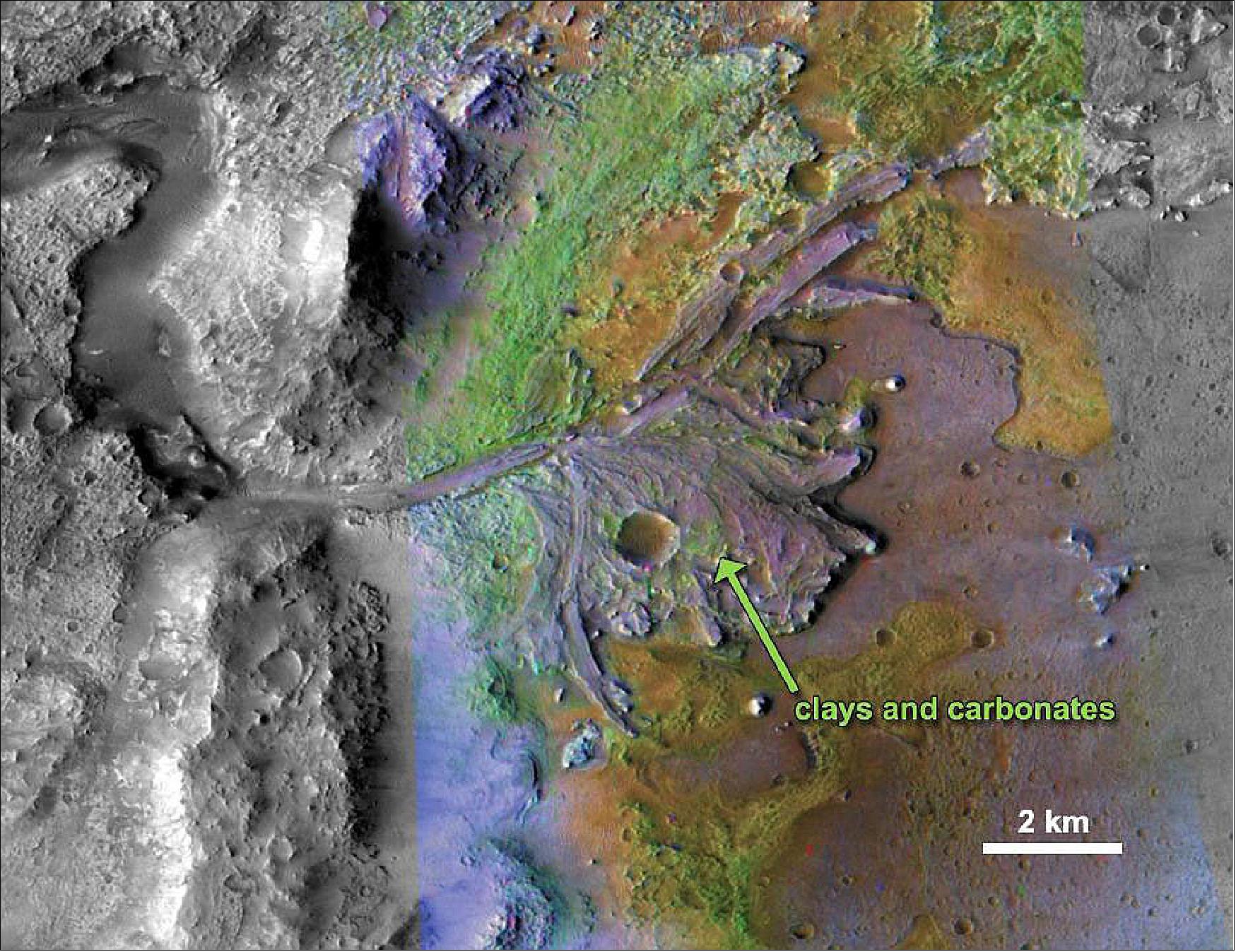
• December 4, 2012: NASA announced the Mars 2020 mission at the fall meeting of the American Geophysical Union in San Francisco. 16)
- In an ongoing effort to restructure its Mars exploration program in the wake of deep budget cuts announced earlier this year, NASA announced plans Tuesday to send a new $1.5 billion rover to the red planet in 2020 based on the design of the agency's hugely successful Curiosity.
References
1) "NASA 'Optometrists' Verify Mars 2020 Rover's 20/20 Vision," NASA/JPL, 5 August 2019, URL: https://www.jpl.nasa.gov/news/news.php?release=2019-158
2) "MEDLI2 Installation on Mars 2020 Aeroshell Begins," NASA/JPL News, 2 August 2019, URL: https://www.jpl.nasa.gov/news/news.php?release=2019-156
3) "Fueling of NASA's Mars 2020 Rover Power System Begins," NASA/JPL, 24 July 2019, URL: https://www.jpl.nasa.gov/news/news.php?release=2019-151
4) "Mars 2020 Rover: T-Minus One Year and Counting," NASA/JPL, 17 July 2019, URL: https://www.jpl.nasa.gov/news/news.php?feature=7459&utm_source=iContact&
utm_medium=email&utm_campaign=nasajpl&utm_content=mars2020-20190717-1
5) "Mars 2020 Rover Gets a Super Instrument," NASA/JPL, 2 July 2019, URL: https://www.jpl.nasa.gov/news/news.php?feature=7443&utm_source=iContact&
utm_medium=email&utm_campaign=nasajpl&utm_content=mars2020-20190702-1
6) DC Agle, "A Neil Armstrong for Mars: Landing the Mars 2020 Rover," NASA/JPL News, 1 July 2019, URL: https://www.jpl.nasa.gov/news/news.php?feature=7442&utm_source=iContact&
utm_medium=email&utm_campaign=nasajpl&utm_content=mars2020-20190701-1
7) "Mars 2020 Rover Gets Its Wheels," NASA/JPL, 20 June 2019, URL: https://www.jpl.nasa.gov/news/news.php?feature=7432&utm_source=iContact&
utm_medium=email&utm_campaign=nasajpl&utm_content=mars2020-20190620-1
8) "NASA's Mars 2020 Will Blaze a Trail - for Humans," NASA/JPL, 12 June 2019, URL: https://www.jpl.nasa.gov/news/news.php?feature=7422&utm_source=iContact&
utm_medium=email&utm_campaign=nasajpl&utm_content=daily-20190612-3
9) "NASA's Mars 2020 Gets HD Eyes," NASA/JPL, CalTech, 31 May 2019, URL: https://www.jpl.nasa.gov/news/news.php?feature=7414&utm_source=iContact&
utm_medium=email&utm_campaign=nasajpl&utm_content=daily-20190531-2
10) "NASA's Mars 2020 Gets a Dose of Space Here on Earth," NASA/JPL, 23 May 2019, URL: https://www.jpl.nasa.gov/news/news.php?release=2019-098
11) "Mars 2020 Is Coming Together," NASA/JPL, 17 May 2019, URL: https://www.jpl.nasa.gov/news/news.php?feature=7405&utm_source=iContact&
utm_medium=email&utm_campaign=nasajpl&utm_content=mars2020-20190517-1
12) "Take it Beyond the Limit: Lockheed Martin Completes Critical Testing Milestone for NASA JPL's Mars 2020 Rover Heat Shield ," PR Newswire, 02 May 2019, URL: https://www.prnewswire.com/news-releases
/take-it-beyond-the-limit-lockheed-martin-completes-critical-testing-
milestone-for-nasa-jpls-mars-2020-rover-heat-shield-300842884.html
13) https://www.jpl.nasa.gov/spaceimages/details.php?id=PIA23160&utm_source=iContact&
utm_medium=email&utm_campaign=nasajpl&utm_content=mars2020-20190424-1
14) DC Agle, "NASA's Mars 2020 Rover Is Put to the Test," NASA News, 19 March 2019, URL: https://mars.nasa.gov/news/8421/nasas-mars-2020-rover-is-put-to-the-test/
15) "NASA Announces Landing Site for Mars 2020 Rover," NASA Science, 19 November 2018, URL: https://mars.nasa.gov/news/8387/nasa-announces-landing-site-for-mars-2020-rover/
16) William Harwood, "NASA announces plans for new $1.5 billion Mars rover," CNET, 4 December 2021, URL: https://www.cnet.com/news/nasa-announces-plans-for-new-1-5-billion-mars-rover/
The information compiled and edited in this article was provided by Herbert J. Kramer from his documentation of: "Observation of the Earth and Its Environment: Survey of Missions and Sensors" (Springer Verlag) as well as many other sources after the publication of the 4th edition in 2002. - Comments and corrections to this article are always welcome for further updates (eoportal@symbios.space).